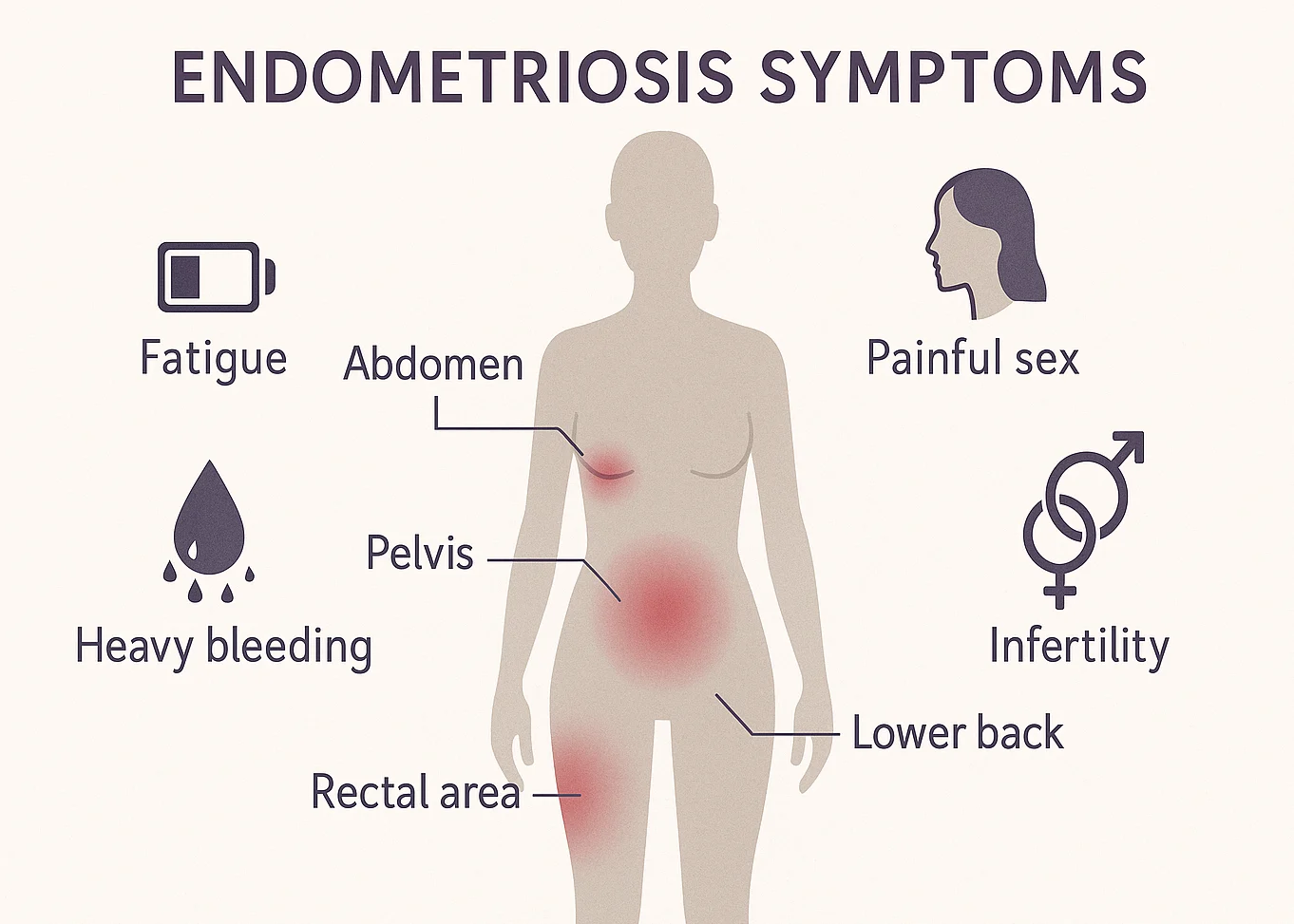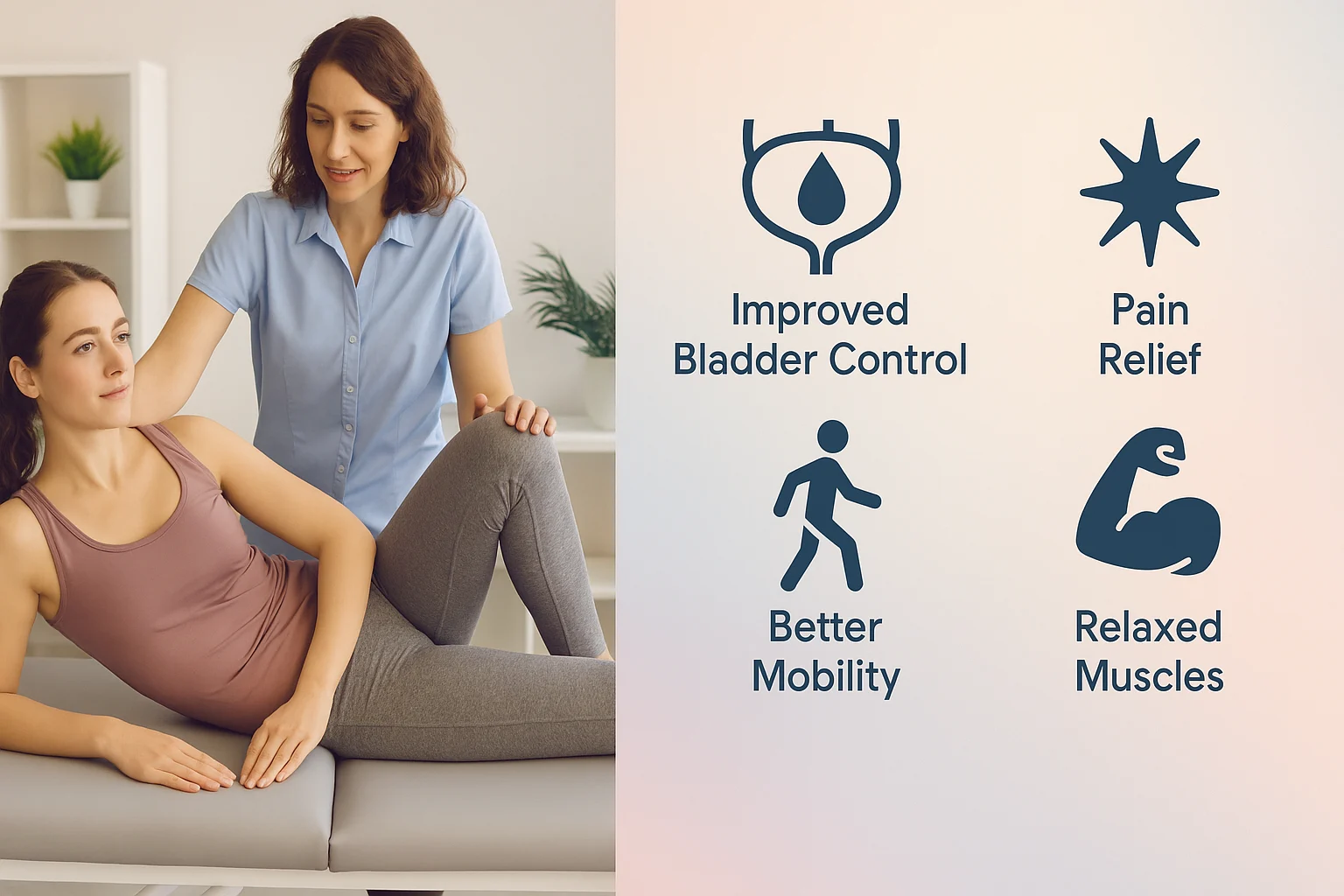
If endometriosis pain has you feeling stuck, I hear you—it’s tough, but there’s hope. Many people ask, can pelvic floor therapy help with endometriosis? This hands-on care may help reduce pain, improve mobility, and calm tense pelvic muscles. To see how it fits into a bigger plan, explore our women’s pelvic health guide.
Table of Contents
- Key Takeaways for Endometriosis Relief
- What Is Endometriosis and Its Impact?
- Understanding the Pelvic Floor’s Role
- Pelvic Floor Therapy for Endometriosis: How It Helps
- What to Expect from Pelvic Floor Therapy
- Long-Term Results from Pelvic Floor Therapy
- Pelvic Relief Helper (1-Click)
- Finding a Qualified Pelvic Floor Therapist
- Holistic Endometriosis Management
- Frequently Asked Questions
- Conclusion
Can Pelvic Floor Therapy Help with Endometriosis? Key Takeaways
- Pain Connection: Endometriosis can make your pelvic muscles tense up, but targeted pelvic therapy can ease this tightness.
- Pain Relief Without Meds: This therapy soothes muscle spasms and sensitive nerves, offering natural relief from pelvic discomfort.
- Easier Daily Life: Can this therapy help with symptoms like pain when moving or during intimacy? Yes, it makes daily activities more comfortable, working well with exercises for recovery.
- Tools for You: You’ll learn exercises and relaxation tricks to manage symptoms on your own.
- Whole-Body Care: Pairing therapy with other treatments creates a well-rounded approach to endometriosis.
What Is Endometriosis and Its Impact?
Endometriosis is more than just tough periods—it’s a condition where tissue like the uterine lining grows in places it shouldn’t, like your ovaries or fallopian tubes. This tissue acts like it’s still in the uterus, thickening and bleeding during your cycle, but with nowhere to go, it causes inflammation, scars, and sometimes cysts. The result? Pain that can disrupt your life, including:
- Intense pelvic pain during periods.
- Pain during or after intimacy.
- Discomfort when using the bathroom during your period.
- Heavy or irregular bleeding.
- Constant exhaustion.
- Challenges with fertility.

This chronic pain can stress your pelvic floor muscles, making them tight or weak. That’s why many people consider pelvic therapy for the muscle tension caused by endometriosis. In many cases, pelvic floor physical therapy may help manage muscle-related pain linked to endometriosis, as supported by clinical insights from sources like the Mayo Clinic.
This post has affiliate links. We may earn a commission. Learn more.
How Targeted Pelvic Therapy Eases Endometriosis-Related Muscle Pain
Endometriosis and pelvic floor issues often go hand in hand. Here’s how they’re connected and why therapy may help:
- Pain’s Impact: Ongoing pain can make pelvic muscles tense up to protect you, causing spasms.
- Inflammation: Endometriosis can irritate nearby nerves and muscles; gentle therapy may help calm this.
- Scar Tissue: Adhesions can restrict movement and tug on muscles, creating stiffness.
- Sensitive Nerves: Chronic pain increases sensitivity; down-training can help reduce reactivity.
- Changed Movement: Guarded movement patterns can overload the pelvic floor.
Pelvic muscles often shift into “protection mode” with chronic pain. Gentle pelvic floor therapy aims to relax guarded tissues and retrain movement patterns.
Understanding the Pelvic Floor’s Role
Your pelvic floor is like a supportive hammock of muscles, ligaments, and tissues at the base of your pelvis. It holds up organs, helps with bladder and bowel control, enhances intimacy, and keeps your spine stable. But endometriosis pain can make these muscles too tight or weak, throwing things off balance. Pelvic floor treatment is often explored to restore balance and reduce nerve sensitivity.
Pelvic Floor Therapy for Endometriosis: How It Helps
Yes, targeted pelvic floor therapy may support people with endometriosis by addressing muscle and nerve pain. It tackles muscle and nerve drivers of pain so daily life feels more manageable. A Mayo Clinic overview lists physical therapy among supportive options.
How Pelvic Therapy Supports Pelvic Pain Relief
Endometriosis pain is tough, but pelvic floor therapy may help provide relief by:
- Releasing Tension: Manual therapy, including gentle massage, eases muscle spasms in the pelvic floor, hips, and abdomen.
- Improving Circulation: Relaxing tight tissues enhances blood flow and reduces inflammation.
- Calming Nerves: Techniques desensitize overactive nerves, lowering pain sensitivity.
- Treating Referred Pain: Addresses pain that radiates to the lower back, hips, or legs.
Enhancing Mobility and Function
Endometriosis can make everyday tasks feel impossible, but pelvic floor therapy can improve how you move and feel, easing pelvic discomfort. For those facing intimacy challenges after medical procedures, these techniques can also support recovery:
- Easing Movement: Reducing muscle tension improves comfort during sitting, standing, or walking.
- Reducing Pain During Sex: Therapy addresses muscle tightness, making intimacy more comfortable. Can pelvic floor therapy help with endometriosis-related painful sex? Yes, it can make a difference.
- Improving Bladder/Bowel Control: Retraining muscles can reduce urgency, frequency, or pain during elimination.
- Boosting Core Stability: Strengthening pelvic and core muscles enhances overall stability.

Empowering Long-Term Wellness
Beyond clinic sessions, pelvic therapy supports endometriosis recovery by equipping you with tools for ongoing relief, like pelvic floor exercises for beginners. Long-term, therapy may give you tools for daily symptom control and resilience:
- Education: Learn about your pelvic anatomy and how endometriosis impacts it.
- Home Exercises: Practice stretches, strengthening, and relaxation techniques to manage pain.
- Breathing Techniques: Diaphragmatic breathing relaxes the pelvic floor and nervous system.
- Pain Management: Use self-massage and stress-reduction strategies for symptom relief.
The goal of pelvic floor therapy is to give you practical tools—relaxation, movement, and pacing—to manage symptoms day to day.
What to Expect from Pelvic Floor Therapy
Curious about what pelvic therapy is like? Here’s what to expect and how it may support endometriosis symptom relief and pelvic pain relief:
Initial Assessment
Your first session is a deep dive into your symptoms and health history. Your therapist may check:
- Posture and Movement: How you stand, sit, or walk to spot any issues.
- External Palpation: Feeling your abdomen, hips, and lower back for tension.
- Internal Exam (Optional): With your consent, a gentle exam to find tight spots or trigger points.
Treatment Techniques
Your plan may include pelvic floor massage tools and other supports:
- Manual Therapy: Gentle techniques to release muscle tension and address adhesions.
- Therapeutic Exercises: Stretching, strengthening, and relaxation moves to boost function.
- Biofeedback: Tools that help you see and control muscle activity.
- Education: Guidance on understanding pain, posture, and pacing flare-ups.
- Modalities: TENS or heat/cold therapy to ease symptoms.
Why Choose a Specialist?
A therapist experienced with endometriosis tailors care to your needs and helps you progress safely.
Long-Term Results from Pelvic Floor Therapy
Pelvic floor therapy may help interrupt the cycle of muscle guarding and nerve sensitivity to support pain management. For example, some individuals, like a 32-year-old woman, report reduced pain during intimacy after several months of therapy, though experiences vary.
Setting Realistic Expectations
- Not a Cure: It targets muscle and nerve components, not endometriosis itself.
- Team Effort: Combine with hormonal therapy or surgery when advised.
- Stick With It: Regular exercises and sessions support lasting results.
- Different for Everyone: Some see major changes; others improve steadily.

Pelvic Relief Helper (1-Click)
Choose one area to see quick tips
Select a single area below and you’ll get simple, evidence-informed ideas you can discuss with your therapist. Picking another area will switch the tips.
Finding a Qualified Pelvic Floor Therapist
Finding the right therapist is important when exploring pelvic floor therapy for endometriosis. Here’s how to get started:
- Look for Experts: Choose a therapist trained in pelvic health or chronic pelvic pain.
- Endometriosis Know-How: Make sure they understand endometriosis to tailor care.
- Ask Around: Your gynecologist or support groups can point you to great therapists.
- Feel Comfortable: You should feel safe and listened to during your sessions.
Holistic Endometriosis Management
Pelvic floor therapy can help with endometriosis, but combining it with other approaches, like building emotional intimacy, can amplify results:
- Eat for Relief: Anti-inflammatory foods can help ease symptoms.
- Stress Less: Try yoga or meditation to calm your nervous system and support therapy.
- Move Gently: Walking or swimming can lift your spirits alongside therapy.
- Find Your Community: Support groups offer encouragement for your journey.
Frequently Asked Questions
Conclusion
Living with endometriosis is challenging, but pelvic floor therapy may reduce discomfort, improve function, and develop tools for ongoing relief.